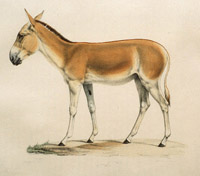Institut für Biologie der Martin-Luther-Universität Halle-Wittenberg
Winter Pasture Conditions and Forage Use by Argali (Ovis ammon) in Gobi Gurvan Saykhan National Park
Date of this Version
2005
Document Type
Article
Citation
Erforschung biologischer Ressourcen der Mongolei (2005) 9: 71-76.
Proceedings of the symposium ”Ecosystem Research in the Arid Environments of Central Asia: Results, Challenges, and Perspectives,” Ulaanbaatar, Mongolia, June 23-24, 2004.
Abstract
Conservation of Argali sheep (Ovis ammon) presents a significant challenge to biologists and conservation managers in Mongolia. Argali are endangered and available data suggest that their numbers are declining. However, the mechanisms causing this decline are poorly understood. Recent research suggests that declines in Argali sheep numbers may be due in part to competition with domestic livestock for forage.
Following privatization of herd ownership in 1991, livestock numbers increased dramatically across Mongolia. With this increase, many herders expanded grazing onto more marginal rangeland resulting in increased competition with wild ungulates and displacement of Argali from their former population strongholds. Although protected areas encompass a considerable number of these strongholds, livestock grazing is permitted within all protected areas and overgrazing is an increasing concern.
In this study, we examined winter pasture conditions and forage use of Argali in the Gobi Gurvan Saykhan National Park. Visual documentation of plant species selected by Argali was conducted in the field using a spotting scope. Following each observation, we visited the forage site in order to identify all above ground plant species, determine canopy cover, and assess winter conditions using Shennikov’s method (1964). We examined a total of 22 Argali forage sites in November 1999. Within the sampled areas, total vegetation canopy cover averaged 50–60 %. Agropyron cristatum, Stipa spp., Artemisia frigida, and Arenaria capillaris were the most dominant plant species.
Argali were observed to select the following plant species as winter forage: Stipa spp., Festuca lenensis, Agropyron cristatum, Koeleria macrantha, Poa attenuata, Carex duriuscula, Carex korshinskyi, Allium eduardii, Kochia prostrata, Amygdalus pedunculata, Caragana pygmaea, Stellaria dichotoma, Bupleurum bicaule, Caryopteris mongholica, Ajania fruticulosa, Artemisia santolinifolia, and Artemisia frigida. The results obtained by this study will serve as a baseline for the development of more comprehensive studies on Argali habitat use and availability. Further studies will support the development of management objectives for the conservation of the species and its habitat.
Included in
Asian Studies Commons, Biodiversity Commons, Desert Ecology Commons, Environmental Sciences Commons, Nature and Society Relations Commons, Other Animal Sciences Commons, Terrestrial and Aquatic Ecology Commons, Zoology Commons



Comments
Copyright 2005, Martin-Luther-Universität. Used by permission.